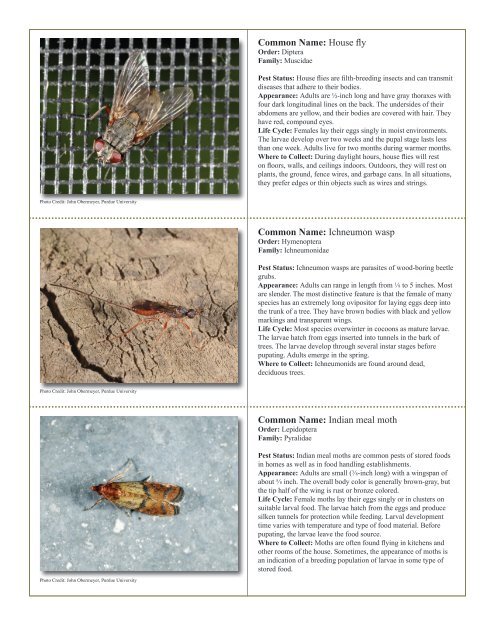to download pdf - Purdue Extension Entomology - Purdue University
to download pdf - Purdue Extension Entomology - Purdue University
to download pdf - Purdue Extension Entomology - Purdue University
You also want an ePaper? Increase the reach of your titles
YUMPU automatically turns print PDFs into web optimized ePapers that Google loves.
Common Name: House fly<br />
Order: Diptera<br />
Family: Muscidae<br />
Pest Status: House flies are filth-breeding insects and can transmit<br />
diseases that adhere <strong>to</strong> their bodies.<br />
Appearance: Adults are ½-inch long and have gray thoraxes with<br />
four dark longitudinal lines on the back. The undersides of their<br />
abdomens are yellow, and their bodies are covered with hair. They<br />
have red, compound eyes.<br />
Life Cycle: Females lay their eggs singly in moist environments.<br />
The larvae develop over two weeks and the pupal stage lasts less<br />
than one week. Adults live for two months during warmer months.<br />
Where <strong>to</strong> Collect: During daylight hours, house flies will rest<br />
on floors, walls, and ceilings indoors. Outdoors, they will rest on<br />
plants, the ground, fence wires, and garbage cans. In all situations,<br />
they prefer edges or thin objects such as wires and strings.<br />
Pho<strong>to</strong> Credit: John Obermeyer, <strong>Purdue</strong> <strong>University</strong><br />
Common Name: Ichneumon wasp<br />
Order: Hymenoptera<br />
Family: Ichneumonidae<br />
Pest Status: Ichneumon wasps are parasites of wood-boring beetle<br />
grubs.<br />
Appearance: Adults can range in length from 1 ⁄8 <strong>to</strong> 5 inches. Most<br />
are slender. The most distinctive feature is that the female of many<br />
species has an extremely long oviposi<strong>to</strong>r for laying eggs deep in<strong>to</strong><br />
the trunk of a tree. They have brown bodies with black and yellow<br />
markings and transparent wings.<br />
Life Cycle: Most species overwinter in cocoons as mature larvae.<br />
The larvae hatch from eggs inserted in<strong>to</strong> tunnels in the bark of<br />
trees. The larvae develop through several instar stages before<br />
pupating. Adults emerge in the spring.<br />
Where <strong>to</strong> Collect: Ichneumonids are found around dead,<br />
deciduous trees.<br />
Pho<strong>to</strong> Credit: John Obermeyer, <strong>Purdue</strong> <strong>University</strong><br />
Common Name: Indian meal moth<br />
Order: Lepidoptera<br />
Family: Pyralidae<br />
Pest Status: Indian meal moths are common pests of s<strong>to</strong>red foods<br />
in homes as well as in food handling establishments.<br />
Appearance: Adults are small ( 3 ⁄8-inch long) with a wingspan of<br />
about 5 ⁄8 inch. The overall body color is generally brown-gray, but<br />
the tip half of the wing is rust or bronze colored.<br />
Life Cycle: Female moths lay their eggs singly or in clusters on<br />
suitable larval food. The larvae hatch from the eggs and produce<br />
silken tunnels for protection while feeding. Larval development<br />
time varies with temperature and type of food material. Before<br />
pupating, the larvae leave the food source.<br />
Where <strong>to</strong> Collect: Moths are often found flying in kitchens and<br />
other rooms of the house. Sometimes, the appearance of moths is<br />
an indication of a breeding population of larvae in some type of<br />
s<strong>to</strong>red food.<br />
Pho<strong>to</strong> Credit: John Obermeyer, <strong>Purdue</strong> <strong>University</strong>
















